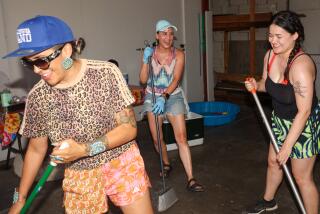Young Apache Embraces the Ritual of Adulthood
EAST FORK, Ariz. — The sky is but a shadow when the girl walks onto the field just before dawn.
In the distance, a campfire crackles. The aroma of potatoes and bacon, fresh tortillas browning over the fire, drifts in the breeze.
“Say a prayer before you start,” her grandmother calls.
The girl’s name is Claudia Griggs, but everyone calls her Angel. She is 15, though on this day her face is solemn, more like the woman she is soon to become than the girl she is.
She is dressed in the ceremonial costume of her Apache heritage: a fringed buckskin serape the color of the sun and clouds, a beaded necklace adorned with butterflies. An abalone shell, representing purity, rests on her forehead. An eagle feather, symbolizing a long, healthy life, is tied to her dark hair.
She clasps a cane strung with bells and feathers, to be saved for when she grows old.
At half past 5 on this Saturday morning, Angel takes her position in the center of the old cornfield. Her parents by her side, she bows her head as a medicine man prays.
Angel is about to begin the most important day of her young life. Over the next 5 1/2 hours she will dance almost continuously as part of an ancient coming-of-age ceremony called the Sunrise Dance.
Na’ii’ees in Apache, the dance marks the passage to womanhood. During the ceremony, the girl becomes “Changing Woman,” who was impregnated by the sun and the rain, and gave birth to the first Apache people.
The four-day ceremony begins on a Friday night, when the girl is dressed in traditional costume. The dance takes place Saturday morning, followed by a painting ceremony the next day to symbolize the final metamorphosis to womanhood. On the final day, the girl’s costume is removed.
Mentally and physically tough for any young girl, the ceremony is especially challenging for Angel, who had a third of her right lung removed several years ago because of respiratory problems. She still suffers from chronic asthma and takes antibiotics.
For Angel, the ceremony means not only growing up, but perhaps, she hopes, growing stronger.
“I was sick,” she says, “and I didn’t want to be that way.”
Standing in the field, she raises her head as the medicine man finishes praying. Six men--drums in hand--begin pounding a constant beat, chanting in a language even Angel barely understands.
Facing east, as the first glimmer of a new day ignites the sky, the young Apache begins her Sunrise Dance.
Traditions are fading fast among American Indians. Church services replaced ancient ceremonies. Fast-food supplanted community gardens. Hospitals edged out medicine men. The children speak English, not Navajo or Apache.
In many Indian communities, preserving the culture has become as much of a challenge as erasing poverty, fighting substance abuse and providing health care. The elders are dying, forever burying the customs of the past, and the young ones are too indifferent to learn.
“The connection is lost,” says Joe Joaquin, a Tohono O’odham Indian and president of Keepers of the Treasures, a national group working to preserve Indian culture and languages.
Traditionalists blame missionaries who converted Indians to Christianity in the late 1800s, as well as government-run boarding schools, where children were barred from speaking their native tongue and practicing their religion.
“They were taught that everything you were doing is not the way it’s supposed to be, that you have to learn the American way of life,” Joaquin says. “There are very few communities that are still traditional, that still cling to the old ways.”
At first glance, Arizona’s White Mountain Apache Tribe isn’t one of those. As contemporary as the residents of any mid-size town, tribal members operate a timber company, a ski resort and a casino on 1.6 million acres of land in east-central Arizona.
They live in modern homes and shop at a chain grocery store. Residents estimate that about half the 12,500-member tribe attend the community’s Lutheran, Southern Baptist or Catholic churches.
Yet there are those who still practice the old ways and are fighting to teach a new generation the rituals of their ancestors, particularly the Sunrise Dance.
On any given weekend from May through October, the pine-studded forests and fields of the reservation are filled with onlookers shouting encouragement and dancing along with a young girl performing the Sunrise Dance.
But fewer families participate these days. Some blame the time and cost--nearly a year of preparation and several thousand dollars. Expenses include the girl’s costume, gifts that are exchanged during the ceremony and fees for medicine men and ceremonial dancers.
Others simply no longer believe in the practice.
“They think it’s a pagan ceremony,” says Cline Griggs, Angel’s father. He insists the traditions must be passed on--to his children and their children--if the Apache way of life is to survive.
“I want the same rights and the same privileges that I have now for them and their kids,” he says. “That’s why we must hold on.”
By 7 a.m., the crowd has swelled to a few dozen people. Young girls and elderly women in calico camp dresses dance in a semicircle around Angel as she shuffles her feet to the drumbeat--left-right, left-right, left-right--the bells on her cane jingling with each movement.
Angel stares into the strengthening sun, unsmiling and concentrating.
Until her costume is removed Monday morning, Angel must abide by certain rituals. She must not shower, because it might wash away the power of Changing Woman. She may drink only through a reed tube, or it is said she will grow a mustache. And she must use a stick to scratch herself, or she might develop sores.
But the true test of strength and will is the dance itself. As 32 songs are chanted and drummed, Angel reenacts the creation cycle and becomes Changing Woman.
“It’s a very moving ceremony for a young Apache girl, because they say after this, you grow up,” Angel explains. “You don’t become a little girl again. You have to be more responsible and mature.”
She pauses as her own words sink in, then offers: “It’s really hard when you think about it.”
“Angel, come on!” a woman shouts from the audience.
It’s 8 a.m., and Angel has dropped to her knees atop a buckskin and a pile of blankets. She sways back and forth with her arms stretched toward the sky. Her hair clings to her wet neck and beads of sweat dot her forehead as she grimaces in exhaustion. Her mother wonders if she can do it.
The sun is burning strong now, scalding the skin. Women pull their hair back and fan themselves. Angel falls onto her stomach, head held up toward the sun as her godmother massages her limbs for renewed strength. In minutes, she’s back on her feet.
“Dance, Angel. Dance!” a spectator demands. She complies, bobbing left-right, left-right, left-right.
By 9 a.m., there are at least 100 people in the audience--women with babies, men smoking cigarettes, teenagers and old women selling sodas and breakfast burritos from coolers.
Angel’s cane is set in the ground, and she runs around it four times--each representing a stage in her life. The cane is moved again, first to the east, then south, then west and north. She circles it again, as some spectators run behind her, in a show of strength against the fatigue of life.
She resumes dancing as the medicine man empties a basket of candy over her head. The audience closes in to scoop up the goodies, which absorb the power of Changing Woman. Another basket, filled with coins and cash, is dumped over her, and the crowd scurries for more.
Angel dances on as the medicine man blesses her, dusting her head, heart and both shoulders with yellow pollen. One by one, the men in the audience do the same, followed by the women.
Her cheeks and hair caked with yellow dust, Angel places her hands on the back of a woman who recently gave birth. She is said to have healing powers now, and several seek her help.
When the blessings are done, the audience links arms. Someone whispers that it is the final song--at last! Arms entwined, men, women, girls and boys dance toward Angel as she continues her shuffling.
The song picks up pace, the drums and chants growing louder, as Angel bends down and grabs the buckskin and blankets. She tosses them into the crowd, to the east, south, west and north.
With cheers and applause, the dance is done. The crowd lines up to shake her hand or offer a hug of congratulations. And finally, Angel smiles.
*
Angel is back in the field at dawn the next day. As a crowd gathers once more, her godfather paints her with yellow powder and water, to symbolize the final metamorphosis from childhood to adulthood, from Changing Woman to Angel, the new woman.
“I feel different,” Angel said after her dance that Saturday, her face and hair still dusted with pollen. “It really does change you.”
For those who lament the loss of tradition among Native Americans, one need only see the transformation of Angel Griggs to know the culture survives.
“I’m glad it’s being carried down from one generation to another, because most tribes lost their language and their culture and their tradition, and this tribe hasn’t yet,” says Angel, who hopes one day to hold a Sunrise Dance for her own daughter.
In this community, among these people and their children and grandchildren, the spirit of the past lives on in the future--in the little boy in a cowboy hat beating a drum with all his might; in the girls wearing camp dresses and dancing alongside their mothers; in the admiring glances of Angel’s friends and the wide-eyed stares of toddlers who dream of their own dances one day.
In them, the traditions survive.
More to Read
Sign up for Essential California
The most important California stories and recommendations in your inbox every morning.
You may occasionally receive promotional content from the Los Angeles Times.









